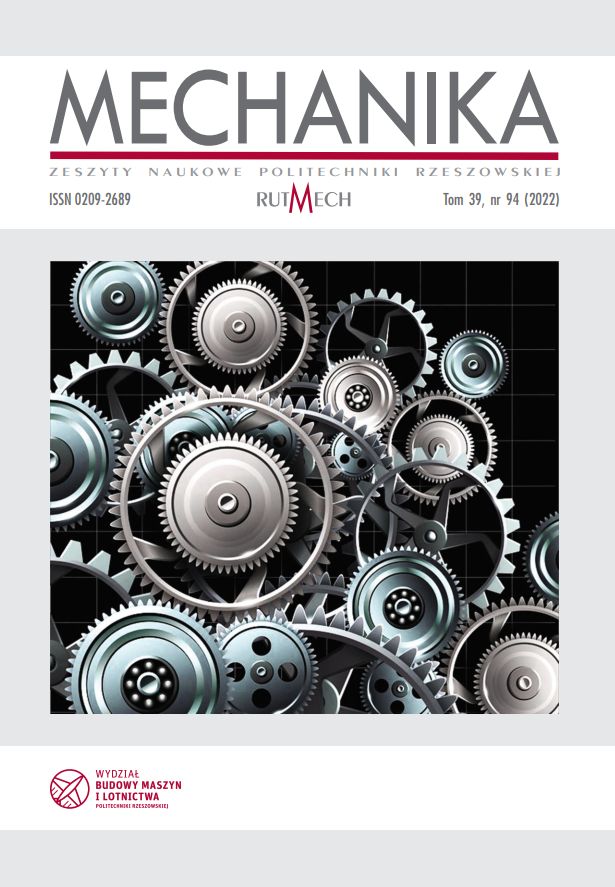Abstract
This article presents the use of a specially designed flat strip drawing tester in order to assess the change in surface topography of DC04 steel sheets. The flat strip drawing test simulates friction conditions in the sheet metal-blankholder interface during deep drawing processes. Experimental tests were carried out at various nominal pressures and in dry friction and lubricated conditions. Two widely available gear and engine oils were used in the study. It was found that, in the range of pressures investigated between 3 and 12 MPa, 80W-90 gear oil provided a greater reduction in the value of the coefficient of friction (COF) than 5W-30 engine oil. Gear oil reduced the COF by an average of about 13.4 [%]. The lubrication efficiency depends on the pressure values; the greater the pressure, the lower the lubrication efficiency. A lowering of the value of the main amplitude surface roughness parameters Sa and Sq was generally observed. SEM analysis showed that even under lubrication conditions there was intense flattening of the roughness asperities of the sheet metal.
References
Antoszewski, B., Evin, E., & Audy, J. (2008). A study of the effect of type (Cu+Ti) and (Mo+Ti) electro-spark coatings on friction in pin-on-disc testing. Journal of Tribology, 130, 0213031–0213036. https://doi.org/10.1115/1.284229.
Costa, H.L., Hutchings, L.M. (2009). Effects of die surface patterning on lubrication in strip drawing. Journal of Materials Processing Technology, 209, 3, 1175-1180. https://doi.org/10.1016/j.jmatprotec.2008.03.026.
Emments, W.C. (1997). Tribology of flat contacts and its application in deep drawing. Ph.D. Thesis. University of Twente.
Evin, E., Daneshjo, N., Mareš, A., Tomáš, M., & Petrovčiková, K. (2021). Experimental assessment of friction coefficient in deep drawing and its verification by numerical simulation. Applied Sciences, 11, 2756. https://doi.org/10.3390/app11062756.
Filali, O., Dubois, A., Moghadam, M., Nielsen, C.V., Dubar, L. (2022). Numerical prediction of the galling of aluminium alloys in cold strip drawing. Journal of Manufacturing Processes, 73, 340-353. https://doi.org/10.1016/j.jmapro.2021.11.008.
Kirkhorn, L., Frogner, K., Andersson, M., & Ståhl, J.E. (2012). Improved tribotesting for sheet metal forming. Procedia CIRP, 3, 507–512. https://doi.org/10.1016/j.procir.2012.07.08.
Recklin, V., Dietrich, F., & Groche, P. (2018). Influence of test stand and contact size sensitivity on the friction coefficient in sheet metal forming. Lubricants, 6, 41. https://doi.org/10.3390/lubricants6020041.
Roizard, X., Pothier, J.M., Hihn, J.Y., & Monteil, G. (2009). Experimental device for tribological measurement aspects in deep drawing process. Journal of Materials Processing Technology, 209(3), 1220-1230. https://doi.org/10.1016/j.jmatprotec.2008.03.023.
Schell, L., Emele, M., Holzbeck, A., & Groche, P. (2022). Investigation of different lubricant classes for aluminium warm and hot forming based on a strip drawing test. Tribology International, 168, 107449. https://doi.org/10.1016/j.triboint.2022.107449.
Severo, V., Vilhena, L., Silva, P.N., Dias, J.P., Becker, D., Wagner, S., & Cavaleiro, A. (2009). Tribological behaviour of W–Ti–N coatings in semi-industrial strip-drawing tests. Journal of Materials Processing Technology, 209(10), 4662-4667. https://doi.org/10.1016/j.jmatprotec.2008.11.040.
Sniekers, R.J.J.M., Smits, H.A.A. (1997). Experimental set-up and data processing of the radial strip-drawing friction test. Journal of Materials Processing Technology, 66, 216–223. https://doi.org/10.1016/S0924-0136(96)02526-5.
Solfronk, P., Sobotka, J., Korecek, D., & Kolnerova, M. (2018). Tribological properties of al-alloy designed for drawing stampings in automotive industry. MM Science Journal, 6, 2354–2357. http://doi.org/10.17973/MMSJ.2018_06_201757.
Stribeck, R. (1902). Die wesentlichen eigenschaften der gleit und rollenlager. Zeitschrift des Vereines Deutscher Ingenieure, 36, 1341–1348.
Tavares, A.F., Lopes, A.P.O., Mesquita, E.A., Almeida, D.T., Souza, J.H.C., & Costa, H.L. (2021). Effect of transfer layers on friction and wear mechanisms in strip drawing tests of commercially coated forming tool. Wear, 476, 203733. https://doi.org/10.1016/j.wear.2021.203733.
Vollertsen, F., Hu, Z. (2006). Tribological size effects in sheet metal forming measured by a strip drawing test. CIRP Annals, 55, 1, 291-294. https://doi.org/10.1016/S0007-8506(07)60419-3.
Vyboch, J., Evin, E., & Kmec, J. (2011). Tribological aspects of numerical simulation of deep-drawing process. Manufacturing Engineering, 3, 38–41.
Wang, C., Guo, B., Shan, D., & Bai, X. (2013). Tribological behaviors of DLC film deposited on female die used in strip drawing. Journal of Materials Processing Technology, 213, 323-329. https://doi.org/10.1016/j.jmatprotec.2012.10.011.


